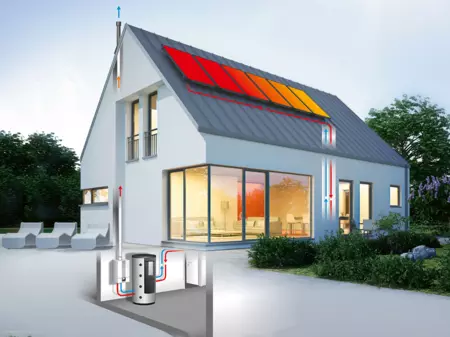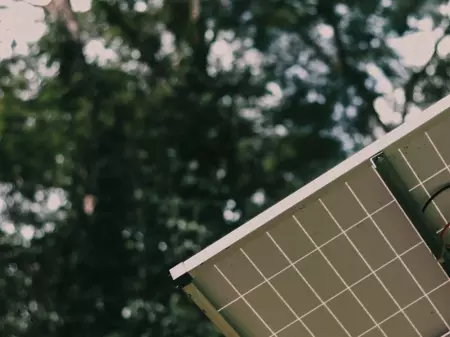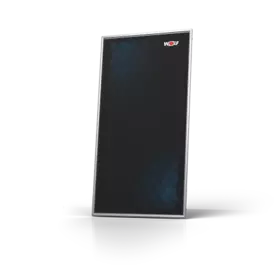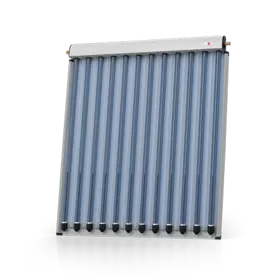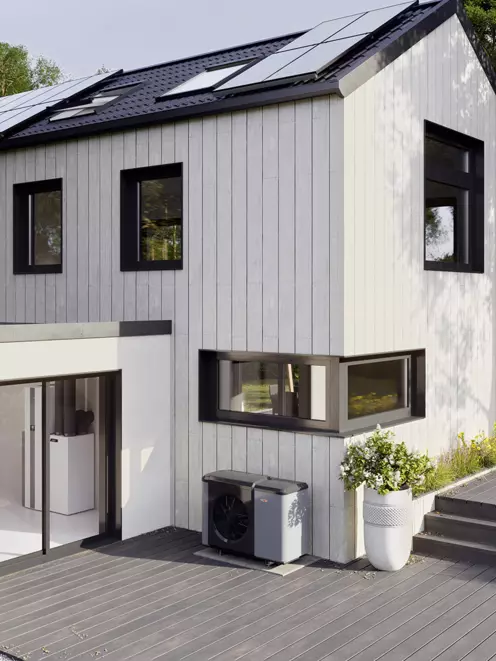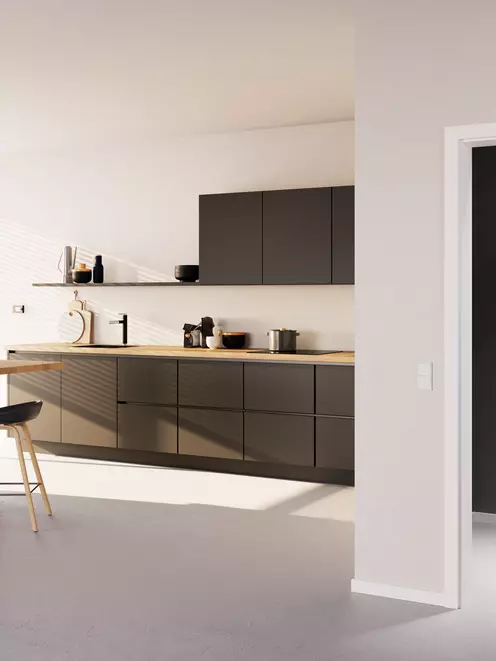Solar thermal systems and photovoltaic systems both use the sun differently as an energy source: solar thermal generates heat, while photovoltaics generate electricity. A solar thermal system generally serves to produce domestic hot water and sometimes also provides central heating backup. The electricity produced by a photovoltaic system can be used in your own home or fed into the public grid.

Understanding solar heating
Free heat for domestic hot water and heating
Solar thermal technology makes use of the freely available energy of the sun for heating your home and/or your hot water – this makes it especially environmentally friendly and efficient. Read on to learn about the advantages of solar thermal, how it works and which product solutions are available.
Table of contents
Heating with the power of the sun
Roughly 2.5 million households already make use of solar heating. It is used to support another main heat generator, generally a system based on combustion, such as gas, oil or wood heating. Thanks to the supplemental solar thermal system, the main unit can operate less intensively. This way, solar thermal technology eases the burden on the environment while also lowering heating costs.
The basic principle of solar thermal technology is very simple. Solar collectors on the roof convert the incoming solar radiation into heat. There are two types available – flat-plate collectors and vacuum tube collectors:
A flat-plate collector converts the solar energy using a thin sheet metal plate with pipes welded to the inside. The metal warms up when hit by sunlight. A special coating ensures that roughly 95% of the solar energy is converted into heat.
A vacuum tube collector has a somewhat different design, but this high-tech solution also makes use of a highly efficient coating.
Regardless of the collector type, the heat obtained flows through a pipe to a heat storage cylinder, from where it can be supplied to your heating system or hot water system. The solar circuit contains an antifreeze solution to prevent the solar thermal system from freezing up in the winter.
Solar thermal technology for domestic hot water
Simple solar collectors only provide the solar energy for producing domestic hot water. Depending on the number of household occupants, 3.5 to 8 m2 of solar collector area are sufficient for this. A storage cylinder is also always a useful companion to a solar thermal system. Only this way can you make efficient use of the energy when the sun is not shining. In this case, the thermal storage cylinder contains water for DHW heating.
With such a system, you can save up to 70% of the energy required for producing domestic hot water. In the summer, the solar heat is generally sufficient and the heating boiler remains idle. As the sunlight tapers off in the autumn, the heating boiler plays a larger role.
By the way, savings are particularly great if you also connect your washing machine and dishwasher to the solar DHW heating system.
Solar thermal for heating and domestic hot water
Do you want to use solar thermal technology to heat your home in addition to producing domestic hot water? No problem. Such a solar system as central heating backup generally needs a larger collector surface. Only this way can the system capture sufficient solar energy during seasons with less solar radiation and greater heating demand.
Solar thermal systems for heating and DHW need a multi-function combi buffer cylinder. Alternatively, you can install a separate storage cylinder for the heating in addition to the DHW cylinder. In order for such a system to provide solar energy for your hot water as well, a heat exchanger transfers the solar heat to the drinking water on demand.
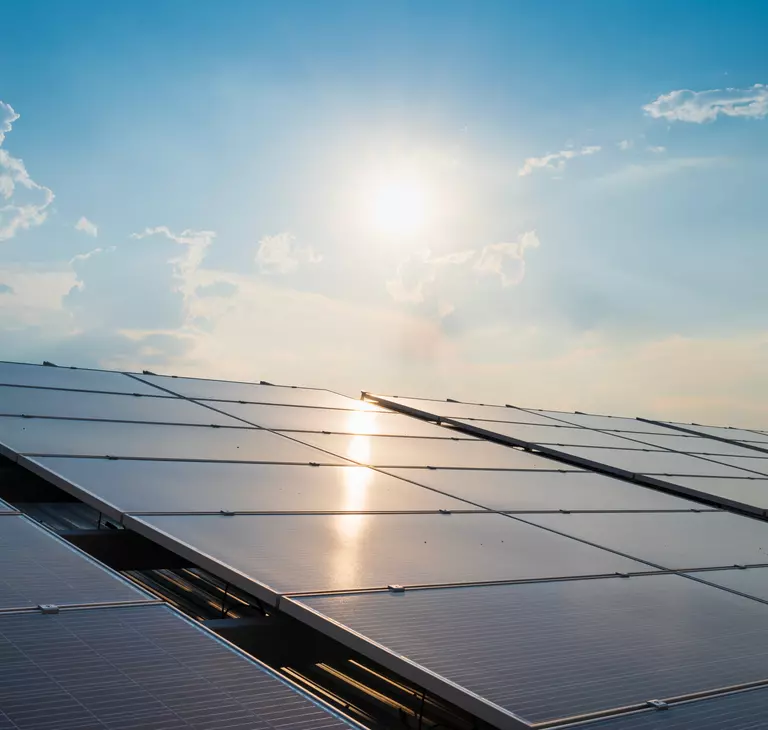
What type of building can benefit from solar heating?
You can use solar heating in almost any house, but you should consider some important details.
In the ideal case, the roof surface faces directly south and has an incline of 30 to 70°.
On flat roofs, the solar collectors can be placed on stands. This makes it easy to orient the collectors to the south. The steeper the roof, the better the solar system can capture the low winter sun and carry out its function as central heating backup. Considering the entire year, an inclination of about 40° is optimal.
One alternative is to install solar collectors on the facade. However, if the roof and facade stand in the shade of another building or high trees, solar thermal technology is not a viable solution.
On older buildings, you should also check the regulations on the protection of historical monuments. In some German states, these can put a crimp in your plans. Also consider any necessary structural alterations for installing the collectors.
New buildings are well suited to solar heating. In this case, heat pumps that allow year-round heating are also increasingly popular.
The investment in solar thermal technology pays off in most cases. With a technically correct installation, the collectors and the storage cylinders will last for decades. Thanks to the savings on heating costs, the solar thermal system will pay for itself in good time.
Thanks to the lucrative subsidy available, this can happen very quickly. For small DHW solar systems, the payback time is somewhat shorter, but solar thermal as central heating backup will save more money over the total lifetime of the system. To each their own: there are many options for different needs.
Frequently asked questions about solar thermal technology
The solar collectors efficiently convert the sunlight into heat during the winter, just like in summer. However, because the sunlight is seven to eight times more intense during the summer, the collectors harvest correspondingly less solar heat in the winter. Even though the performance of solar thermal during the cold season is not sufficient for heating, it can effectively support heating of the home and domestic hot water, especially during the transitional seasons.
In most cases, you can install solar heating without a building permit. Buildings under historic conservation are an exception. Propping up the system on inclined roofs also requires a permit (but not on flat roofs).
The size of your solar heating installation depends on various factors, such as how large a share solar heating should make up in your overall heating setup. Systems with small collector areas save between 20 and 30% of the heating costs for heating and DHW.
The insulation also plays a large role. A solar collector area of 20 m2 can supply a large portion of the heat required by a well-insulated building. During the warmer summer months, up to 100% of the hot water demand can be covered by the solar thermal system. Of course, larger collector areas also require more space for the storage cylinder.
There are already homes today that obtain all of their heat from solar energy with correspondingly large solar collector surfaces and storage cylinders. Such a setup tends to work best in a new construction, since the extensive alterations required in existing buildings would be expensive.
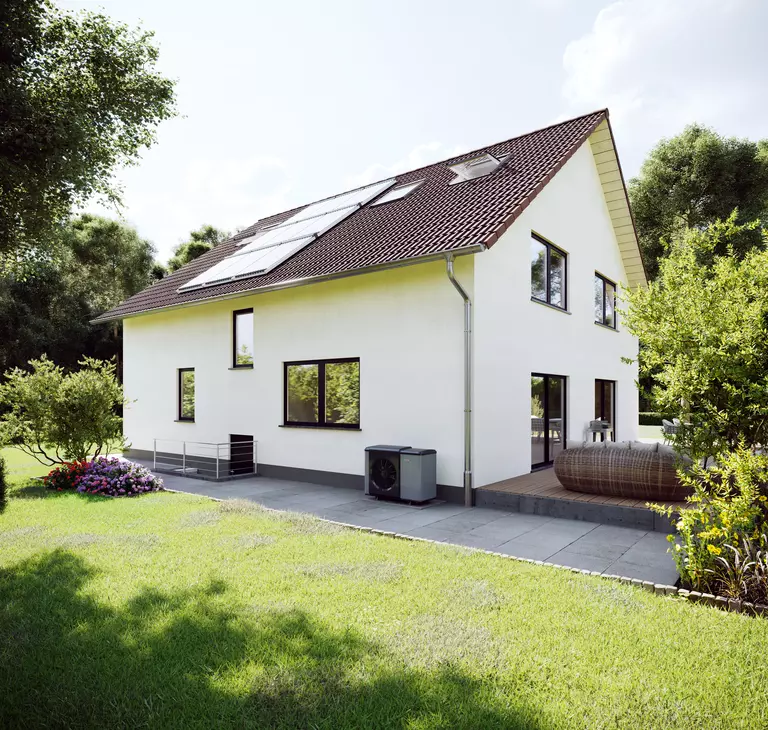
Our recommendation - the CRK tube collector
50 years of experience have gone into the development and design.
